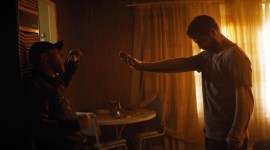
Cinematography Tip: Working with Motivated Camera Movement
Motivated camera movement helps narrate your film visually. Here are a few examples you can put into action in your own work.
On the surface, camera movement appears to just be a technique to make a shot more interesting and keep the audience engaged. When the movement is done well, it can increase the audience’s opinion of your production value. Sometimes, camera movement is necessary to keep up the film’s pace. If suddenly there’s a bunch of action taking place and people running around but the camera is locked down, it tends to slow everything down.
But there’s an important factor to keep in mind when planning your shots, blocking, and camera movement: the camera is the film’s silent narrator. You can use movement to guide the audience through the scene, slowly revealing certain people or objects in order to create suspense — or simply control the pacing of the scene.
Broadly speaking, camera movement, like the narration of a book, can fall into three categories:
- Point-of-view/first-person
- Motivated camera movement/third-person (limited)
- Unmotivated camera movement/third-person (omniscient)
Let’s dive a bit deeper into motivated camera movement. This is movement that the actions on screen dictate. We are literally following the action, whereas unmotivated camera movement means the camera essentially moves freely, detached from any specific action. Keep in mind that motivated camera movement can be as simple as tilting or panning to follow a character walking across the room — or lowering his hand under a table during a shady deal — but you can use it for more than that.
The lens is the storyteller. Think about why the camera is moving in the first place. Spielberg is known for a lot of oners, and using motivated camera movement is a reminder that just because we’re following movement doesn’t mean that we’re limited as storytellers. In Raiders of the Lost Ark, we get an excellent example of this during Marion’s introduction.
In this one shot, we go through several movements. The movement mimics our own entry into the bar, as if we are a customer coming upon the riotous drinking game. The second movement focuses on the two characters involved in the game. We follow their facial expressions and hand movements. (These close-ups allow us to feel what the characters are going through.) As we follow their hands, we see the focused standoff between Marion and her drinking partner, and even though Marion plays up how drunk she is, her handling of the class (which the camera movement focuses on) clues us in that she has the upper hand in the game — compared to her opponent’s sloppy lack of gross motor control.
Motivated camera movement should logically follow the blocking. Gareth Evans uses this idea wonderfully in The Raid: Redemption.
Nearly every camera move in this scene follows a fist, a kick, or a blade, which yields a powerful and amped-up “narration” of this fight scene. Paul Greengrass, director of the Jason Bourne sequels and one of the architects of the shaky cam trend, might have simply added superfluous and nauseating camera shake to this scene to try and amp up the action. However, through strong motivated camera movements, Evans adds incredible kinetic energy while maintaining clear visual narration.
Unless the camera is a character’s POV, it should not have sway over the blocking of the characters. The camera should either follow the blocking or provide an independent, third-person perspective. If the camera alone dictates the blocking, the scene will feel unnatural. Don’t move the characters aimlessly around a room as an excuse to use fancy camera movements.
Cover image via Paramount Pictures.
Looking for more articles on cinematography? Check these out.





